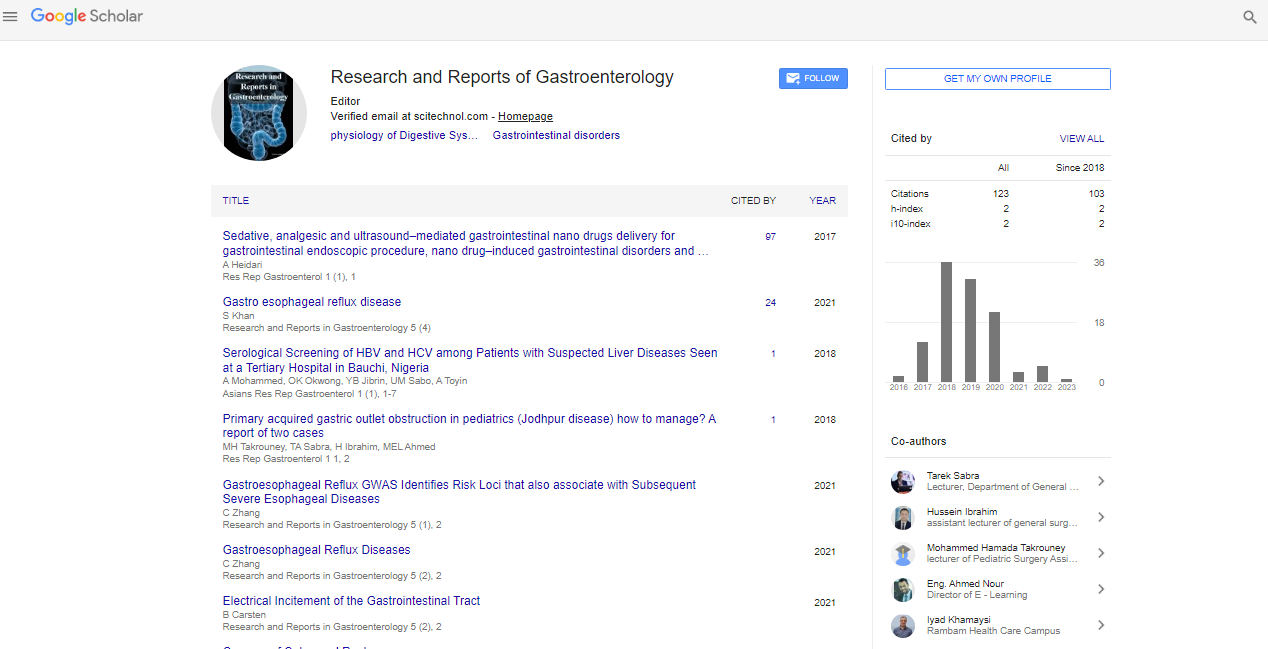Opinion Article, Res Rep Gastroenterol Vol: 7 Issue: 4
Exploring the Complexities of Gastrointestinal Bleeding
Jason Gregoski*
1Department of Public Health, Medical University of South Carolina, Charleston, USA
*Corresponding Author: Jonathan Hursitoglu,
Department of Pediatrics,
University of Virginia, Charlottesville, USA
E-mail: gregoskijason@gmail.com
Received date: 20 November, 2023 Manuscript No. RRG-24-124053;
Editor assigned date: 22 November, 2023, PreQC No. RRG-24-124053 (PQ);
Reviewed date: 06 December, 2023, QC No. RRG-24-124053;
Revised date: 13 December, 2023, Manuscript No. RRG-24-124053 (R);
Published date: 20 December, 2023, DOI: 10.4172/Rrg.1000156
Citation: Gregoski J (2023) Exploring the Complexities of Gastrointestinal Bleeding. Res Rep Gastroenterol 7:4.
Description
Gastrointestinal bleeding, a condition marked by the loss of blood from the digestive tract, is a medical concern that demands attention due to its potential severity and varied causes. The Gastrointestinal (GI) tract, comprising the esophagus, stomach, small intestine, and large intestine, can be a source of bleeding when its delicate lining is compromised. In this article, we delve into the intricacies of gastrointestinal bleeding, exploring its causes, symptoms, diagnostic approaches, and the crucial steps involved in its management.
Causes of gastrointestinal bleeding
Peptic ulcers, open sores that develop on the lining of the stomach or the upper part of the small intestine, can cause bleeding. The erosion of blood vessels within the ulcer can lead to both acute and chronic gastrointestinal bleeding.
Esophageal varices are enlarged veins in the esophagus that often result from liver cirrhosis. These fragile vessels can rupture, causing severe and life-threatening bleeding. Liver diseases that impair blood flow through the liver contribute to the development of esophageal varices.
Inflammation of the stomach lining, known as gastritis, can lead to gastrointestinal bleeding. Chronic irritation and damage to the stomach lining may result in the erosion of blood vessels, causing bleeding.
Colorectal polyps, abnormal growths in the colon or rectum, and colorectal cancer can contribute to gastrointestinal bleeding. The presence of tumors or polyps may cause bleeding, and in advanced stages of cancer, bleeding can become more significant.
Diverticulosis, the formation of small pouches (diverticula) in the walls of the colon, can lead to bleeding if the blood vessels within these pouches rupture. This condition, known as diverticular bleeding, is a common cause of lower gastrointestinal bleeding.
Symptoms and signs
The symptoms of gastrointestinal bleeding can vary depending on the location and severity of the bleeding. Common signs include:
• Indicates upper gastrointestinal bleeding.
• Suggests bleeding in the lower gastrointestinal tract.
• Indicates severe bleeding from the upper digestive tract.
• Results from the loss of blood and decreased blood volume.
• May be present, depending on the cause and location of the bleeding.
Diagnostic approaches
Upper endoscopy or colonoscopy allows direct visualization of the gastrointestinal tract. These procedures enable healthcare professionals to identify the source of bleeding, take biopsies, and, in some cases, provide treatments to stop bleeding. Radiological imaging, such as angiography or CT angiography, can be employed to locate the source of bleeding. This is particularly useful in cases where endoscopy may not be feasible or inconclusive. Laboratory tests, including Complete Blood Count (CBC) and tests for liver function, can provide information about the extent of blood loss and the overall health of the patient.
Patients with significant gastrointestinal bleeding may require supportive measures, including intravenous fluids and blood transfusions to restore lost fluids and replace red blood cells. Endoscopic procedures not only help diagnose the source of bleeding but can also be used for interventions such as sclerotherapy, band ligation, or the application of hemostatic agents to stop bleeding. Proton Pump Inhibitors (PPIs) and H2 blockers are often prescribed to reduce stomach acid production, promoting the healing of ulcers and preventing further bleeding. Cases of severe or recurrent bleeding, surgical intervention may be necessary. This could involve removing a bleeding segment of the intestine, repairing blood vessels, or other surgical procedures based on the underlying cause.
Gastrointestinal bleeding is a multifaceted medical issue that requires a thorough understanding of its causes, symptoms, and appropriate diagnostic and management strategies. Timely identification of the source of bleeding and targeted interventions are crucial for ensuring favorable outcomes and preventing complications associated with significant blood loss. Advances in diagnostic technologies and treatment modalities continue to enhance our ability to address gastrointestinal bleeding, offering hope for improved patient care and outcomes in the realm of digestive health.
 Spanish
Spanish  Chinese
Chinese  Russian
Russian  German
German  French
French  Japanese
Japanese  Portuguese
Portuguese  Hindi
Hindi 